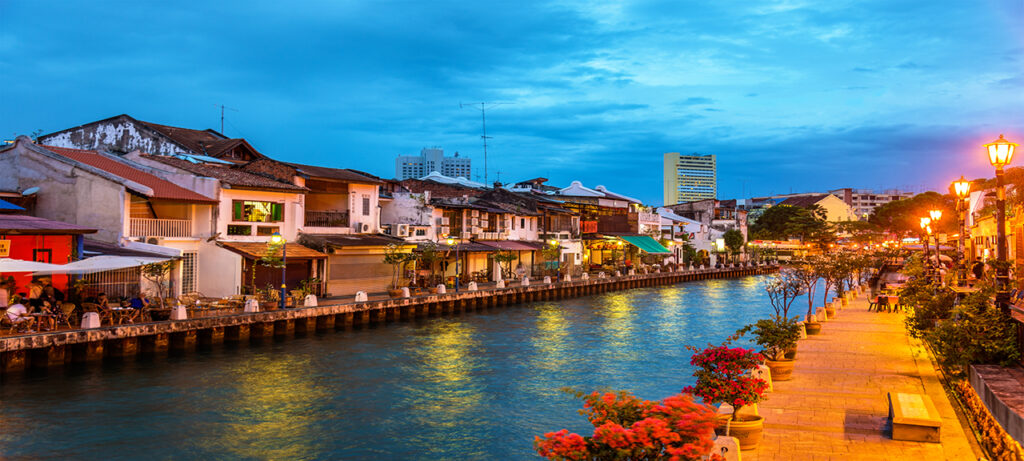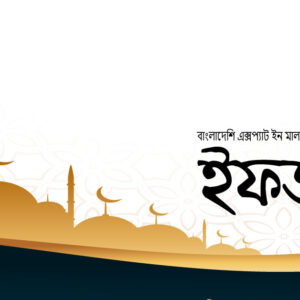Before the arrival of the first Sultan, Malacca was a simple fishing village inhabited by local Malays. Malacca was founded by Parameswara, also called Iskandar Shah or Sri Majara, the last Raja of Singapura (now known as Singapore) following a Majapahit attack in 1377. Parameswara found his way to Malacca in 1400 where he found a port, accessible in all seasons and on the strategically located narrowest point of the Malacca Strait.
Melacca is 2 to 3 hours drive from Kuala Lumpur, depending on road traffic and speed of drive. You can drive or go there by Bus. Southbound buses now leave from new bus terminal Bersepadu Selatan, which is located just next to LRT station and KTM Komuter station Bandar Tasik Selatan. Easiest way to get there from Chinatown, as of March 8, 2016 is to walk to a public bus stop near Ancasa Hotel (a 1 minute walking distance from Kota Raya mall) and take a RapidKL bus clearly marked “”TBS”” for MYR 2.00, the ride takes 15 minutes. Or walk to Kuala Lumpur old railway station (just opposite side of canal from LRT Pasar Seni station, use overpass) and take KTM Komuter train for MYR2.40 or take LRT from Masjid Jamek station. Buses are leaving every half hour, regular price of a ticket to Melaka Sentral is RM10-12, depending on the bus company, ride takes 2 hours. (As of March 8, 2016) Booking tickets online could raise the final price for the ride by as much as 50% due to service fees and other surcharges, so if you’re not on a tight schedule, go straight to the terminal and buy your ticket at one of the numerous counters, with so many buses per day it’s almost impossible not to catch a ride.
What to see,
The older part of the city proper has, in addition to the old palace and the large buildings left by the Europeans, many private houses and shops from nearly a century or more ago, put up by Chinese traders. Many of these have beautiful details such as moulded porcelain tiles and painted plaster reliefs on the front. Unfortunately, they tend to be not well preserved and the city government decided to paint all the buildings in the historical district a bright brick red some years ago, as the constant spitting by passers-by was proving a nuisance, which detracts from their aesthetic value. There is a tourist map provided by Malacca.
Note that on Tuesdays, many museums, shops, restaurant are closed, especially in the Jonker Street area. If you have only one day to spend in Malacca, do not go on Tuesday!
Heritage area
- Baba and Nyonya Peranakan Museum. ☎+60 6 283 1233. Opening hours: 10AM-12:30PM, 2:30PM-4:30PM. Closed on Tuesdays – Step back in time with a visit to this museum which is an actual Peranakan heritage town house and is a great example of Peranakan culture. It is on Heeren Street (now known as Tun Cheng Lock Street). The entry fee is RM15 per person and everyone has to follow a guide-led group. Photography is forbidden.
- Cheng Hoon Teng Temple. [48] 25, Jalan Tokong. ☎+60 6 282 9343. Opening hours: Morning to 7PM – Oldest Chinese temple in Malaysia and has an inscription dating 1685 commemorating the deeds of by Kapitan China Li Wei King.
- Christ Church – this church was built between 1741 and 1753. It replaced a Portuguese church, which was shattered. Bricks were shipped from Zeeland in the Netherlands. On the floor of the church you will find Dutch tombstones. It is the oldest protestant church in Malaysia. On the altar you will see sacramental silverware, still bearing the Dutch coat of arms. 8:30AM-5PM Mon-Sat, free admission; photography is forbidden.
- Dutch Square – Beautiful square around Christ Church and the Stadhuys. On this square you will find the Tang Beng Swee Clock Tower, it looks Dutch, but it is not. It was built in 1886.
- Independence Museum – Located inside the Independence Memorial (which is a building, not just a memorial) right next to A Famosa. Walk through two floors covering Malaysian history, especially leading up to, and past independence. Good exhibits and lots of descriptions. Free.
- Jonker, Heeren and adjacent streets – This is the residential heart of Old Malacca just west of the Malacca River, with its narrow winding streets, beautifully decorated houses, tiny shops, temples and mosques. The whole area is undergoing a renaissance with new shops, restaurants and hotels catering to tourists mushrooming everywhere. However, the area still has a lot of atmosphere and is worth having a look around. One of the streets in this area is Harmony Street (officially Temple street or Jalan Tokong), so called because it contains the prayer houses of Malaysia’s three main faiths – the Cheng Hoon Teng Chinese temple, the Sri Poyatha Vinayagar Moorthi Hindu Temple, and the Kampung Kling Mosque.
- Malaysian Navy Museum, across the road from the Maritime Museum
- Malay and Islamic World Museum, Jalan Kota (beside the Porta de Santiago) – it also currently houses a Museum of Torture (European medieval period) for a limited duration on the ground floor. Entrance fee 15 RM for adult foreigners.
- Masjid Kampung Hulu Built in 1728, it’s one of the oldest functioning mosques in Melaka together with Masjid Kampung Kling and Masjid Tengkera (Tranquerah), Jln Tengkera see the mixed architecture of Chinese, Javanese and Arab on the minarets and the roofs.
- Muzium Budaya/Sultanate Palace – Below the hill you will find this museum (Melaka Cultural Museum). It is a reconstruction of the istana of the sultan Mansur Shah. It was built in 1985. It is open daily from 9AM to 6PM except on Tuesdays, and on Fridays from 12:15PM-2:45PM. Entrance fee RM 2.
- Porta de Santiago – You will find this remains of the old Portuguese fort A Famosa on Jalan Kota, around St Paul’s Hill. What you can see nowadays is a mostly Dutch reconstruction, bearing the VOC coat of arms.
- Saint Paul’s Church – take a path up the hill and it will lead you to this church. It was originally built in 1521, by the Portuguese. It became a fortress in 1567, until 1596. After the Dutch siege it became St Paul’s, before it was known as Nossa Senhora da Annunciada (Our Lady of Annunciation). It has been used as a burial ground for the Dutch. You can still see the tombstones, along the walls of ruins of the church.
- Stadthuys – completed in 1660. It is a reproduction of the former Stadhuis (town hall) of the Frisian town of Hoorn in the Netherlands which existed from 1420 until 1796. Nowadays, it houses the Museums of History and Ethnography. This is one of the oldest Dutch buildings in the east.
- Stamp Museum, Jalan Kota (sandwiched between the Muzium Rakyat and the Malay and Islamic World Museum)
- UMNO Museum, Jalan Kota (between the Islamic Museum and the Muzium Rakyat) – museum about the United Malays National Organisation.
- Youth Museum/Melaka Art Gallery, Jalan Laksamana, beside the Christ Church. The Youth Museum is on the ground floor, the Art Gallery on the second level. You can have a bird’s eye view of Dutch Square from a window on the second level. Open Wed to Sun 9AM-5.30PM; combined admission for adults – RM2
Others
- Bukit China – Bukit China is the one of the largest Chinese cemetery outside of mainland China. Graves can be found here that go back to the late Ming dynasty (mid 17th century). The earliest grave found so far dates to 1622, but unfortunately many graves were exhumed during the British occupation of Malaysia. Bukit China is a famous jogging spot for the locals and jogging tracks are available all over the hill. When you climb on top of the hill, you will have a nice view of the town.
- King’s Well – Legends have it that Hang Liu was a Chinese princess from the Ming dynasty who was sent to Malacca to wed Sultan Mansor Shah in the 15th century when the Malacca Sultanate was at its zenith. She had 500 followers who were all settled on Bukit China, which means Chinese Hill, and this well, at the foot of the hill, was where they got their water.
- Melaka River – Take a relaxing stroll down the river from Jalan Munshi Abdullah. The route takes you along a boardwalk and past a number of chic looking houses decorated with large paintings. You also get a good view of Bukit St Paul over the town.
- Malacca Straits Mosque – a newly built mosque on the man-made island Pulau Melaka located just off the cost of the city. Spectacular at evening and night.
- Poh San Teng Temple – This temple is located at the foot of Bukit China and next to the King’s Well, was founded in 1795 by Kapitan China Chua Su Cheong as a graveyard temple. The main deity is Fu-te Zhen Shen. the temple was built to allow the descendants of those buried on Bukit China to conduct prayers to their ancestors away from the heavy rain and strong winds.
- Portuguese Settlement – Here is where the descendants of the Portuguese who conquered Malacca in 1511 live today. The settlement, located just southeast of the city centre, consists of tidy rows of mostly wooden houses leading up to the Portuguese Square (Malay Medan Portugis) and Hotel Lisboa (sorry, unlike its Macau namesake, there is no casino here) on the waterfront. The people here may look Malay but peer into their houses and you’ll see the characteristic altar with status of Jesus and Mary perched high on their walls. Quite a few still speak Cristao (or Cristang), a Portuguese patois. There are also many restaurants for you to sample Portuguese fare. The most interesting times to visit is during Intrudu – usually in February – when the you’ll get a Songkran-like drenching with buckets of water thrown at you; Festa San Pedro to commemorate the Feast of Saint Peter in June, where there are processions, cultural shows and general merry-making; and Christmas when the whole settlement is decked in decorative lights. Getting there/away: Malacca Town Bus (green) No. 17 (destination “Ujong Pasir and Bandar Hilir”) from Melaka Sentral will bring you right into the Settlement.
- St John’s Hill and Fort. Malacca’s other fortress located on top of St John’s Hill in Bandar Hilir, south of the city. Pretty views of the surroundings from the top. Malacca Town Bus (green) No. 17 passes by this fort.
- Melaka Chinese Mosque – The mosque is designed with a unique Chinese architecture with pagodas and Chinese calligraphy from a combination of architectural design of several mosques in Beijing, Shanghai and Xi’an in China. Located in Jalan Solok Hilir, Paya Rumput near Hang Jebat Stadium.[49][50]
Outside town
- Geok Hu Keng Temple – Located at the junction of Klebang and Jalan Pokok Mangga, about 3km from town centre. This temple has a history of 130 years. Managed by local communities, the temple was incorporated under the management of Cheng Hoon Teng in 2000. Major celebrations – 3rd day of Chinese New Year, Hien Tian Siong Teh’s birthday on 3rd day of 3rd lunar month and the birthday of Geok Hu Tai Chong on 29th day of 6th Lunar Month. To get to the temple, you may hop in any of the Patt Hup Buses and stop slightly opposite the temple or you may take Town Bus No 18 which stop beside the temple.
- Kampung Morten – a village of traditional houses, it is on the west bank of the Malacca River.
- Melaka Zoo – Located in Ayer Keroh, along the main road from the Ayer Keroh toll plaza to Melaka town. The second biggest, one of the best, if not the best, zoo in Malaysia. Even better than the National Zoo. The zoo is in a reserved forest where the animal enclosures more resemble the animals’ natural habitat. The trees within the zoo compound provide ample shades for visitors during hot and sunny days. There is a lake in the zoo. Dattime admission for adults – RM22.5 (9AM- 6PM), night entry – RM22.5 (8PM-11PM)
- Padang Kemunting Sea-Turtle Sanctuary – Located in Pantai Padang Kemunting beach, about 28 km from Melaka Sentral. You can see the most beautiful sea-turtle in the world, the Hawksbill turtle. Relax to the sound of the Straits of Malacca as the are lots of kampong type of resorts (budget) for you to choose. Admission for adults is free, open daily 10AM-4PM. Close on Monday and Malaysian public holidays.
- Recreational Forest Ayer Keroh – The 359 ha (887 acre) Ayer Keroh Recreational Forest was opened on April 17, 1984 and offers visitors peace and tranquility within its cool green surroundings.
- Melaka Botanical Garden, Ayer Keroh – Located next to Ayer Keroh Recreational Forest.
- Taman Mini Malaysia and Mini ASEAN – Located in Ayer Keroh, along the main road from the Ayer Keroh toll plaza to Melaka town, about 1 km from Melaka Zoo between the Zoo and toll plaza. It has full-size reconstructions of typical houses from all 13 Malaysian states and all the members of ASEAN. There are daily cultural shows at 11AM and 2PM. Admission for adults is RM12, open daily 9AM-6PM.
Dont Miss
- Melaka River Cruise – a 45 min cruise along Melaka river where once it was a main trade area of Melaka during its Golden era. It takes passengers from the jetty beside the Maritime Museum to just beyond Kampung Morten and then back. Night cruise is more interesting as we can see lights lit on the riverbank’s buildings, water fountain show and bridges. You will pass through many boardwalk cafes along the way. Wave “hi” as you cruise along happily. The Honky Tonk Cafe will be located along these river bank. Tickets: Adult RM10, Child RM5. Hourly cruise 10AM-11PM daily. Note that dual-pricing is in effect on this boat, foreigners pay more than the prices listed here.
- Jonker Walk Night Market – Jalan Hang Jebat, Friday to Sunday evenings from 6PM-12AM. There are an endless range of souvenirs, antiques and crafts throughout the market, some which are unique to Malacca. There are also a variety of cheap electronics for sale. Be sure to bargain with the vendors. A wide variety of food is also on offer including chicken rice balls, radish cake, cendol (a sweet coconut milk and jelly noodle dessert), Kaya (a spread made from coconut) filled waffles and even grapes dipped in chocolate or caramel encrusted kiwis. There are also free performances held within the market.
- Asam Pedas, the signature dish of the state. A very hot and mild sour fish curry which accompanying white rice. Normally eaten during lunch and dinner. From RM4.50.
Content from Wikitravel Org
Photo from Trails of Indochina





